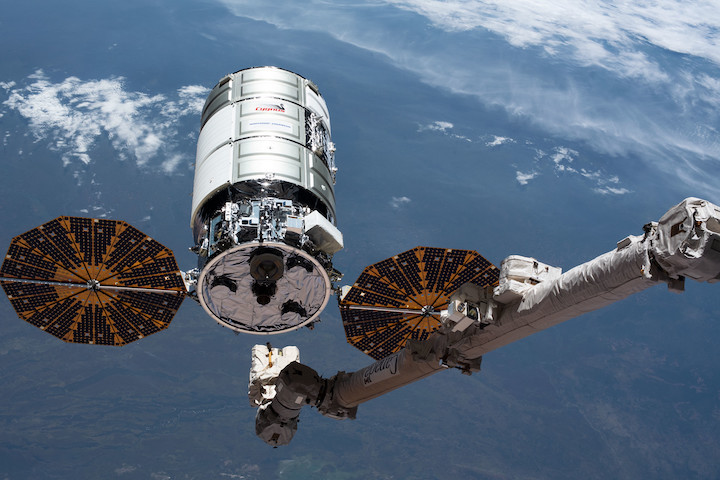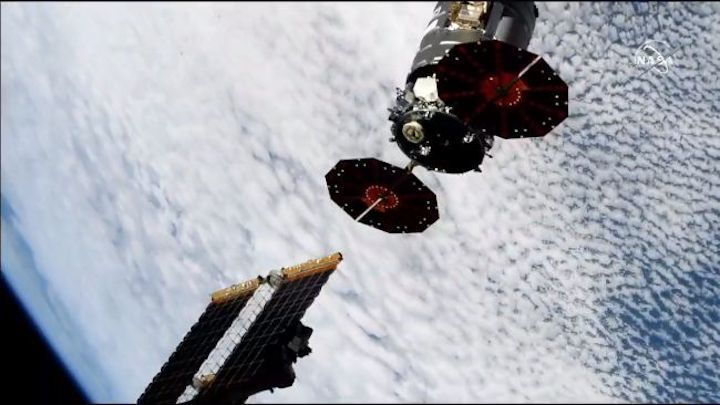26.01.2020

More than two months after delivering several tons of supplies and scientific experiments to the International Space Station, Northrop Grumman’s Cygnus cargo spacecraft, the SS Alan Bean, will depart the orbiting laboratory on Friday, Jan. 31.
Live coverage of the spacecraft’s release will air on NASA Television and the agency’s website beginning at 9:15 a.m. EST, with release scheduled for 9:35 a.m.
Cygnus will demonstrate a new release position for departure operations and will incorporate the first ground-controlled release. The new orientation allows for easier drift away from the station’s Canadarm2 robotic arm. With Expedition 61 Flight Engineers Andrew Morgan and Jessica Meir of NASA providing backup support, ground controllers will send commands to the Canadarm2 robotic arm to release the unpiloted cargo spacecraft after ground controllers remotely unbolt the craft from the Earth-facing port of the Unity module and maneuver it into release position.
Within 24 hours of its release, Cygnus will begin its secondary mission – deploying a series of payloads – before Northrop Grumman flight controllers in Dulles, Virginia, initiate its deorbit and it executes a safe, destructive reentry into Earth’s atmosphere at the end of February.
Quelle: NASA
----
Update: 1.02.2020
.
Cygnus cargo ship leaves International Space Station, begins new mission in orbit
Northrop Grumman's Cygnus NG-12 cargo spacecraft departed the International Space Station today (Jan. 31), nearly three months after it arrived at the orbiting laboratory with about 4 tons of supplies and science experiments for the Expedition 61 crew.
The cargo vessel, named the S.S. Alan Bean after the Apollo 12 astronaut, began its journey back to Earth after ground controllers in Houston used the station's Canadarm2 robotic arm to release it in orbit. Before the spacecraft meets its fiery demise in Earth's atmosphere, it will spend about a month in orbit deploying various scientific payloads.
On Feb. 29, ground controllers will initiate a deorbit maneuver, after which the cargo ship will execute "a safe, destructive reentry into Earth’s atmosphere," NASA officials said in a statement.

"I’d just like to say farewell to the S.S. Alan bean and thank you to the entire Cygnus NG-12 team for making Expedition 61 highly successful," NASA astronaut and Expedition 61 flight engineer Andrew Morgan said during a live webcast of the spacecraft's departure. He and his fellow Expedition 61 crewmember Jessica Meir provided backup support as ground controllers maneuvered the Cygnus away from the space station.
While this isn't the first Cygnus cargo vessel to embark on a secondary mission after leaving the space station — the NG-11 mission also took an extended detour on its way out in August — it was the first to test out a new release procedure. Typically astronauts on board the station manually operate the robotic arm to release these cargo vessels, but this time NASA tried a different method for the S.S. Alan Bean's departure.
"For this mission, Cygnus demonstrated a new release position for departure operations and incorporated the first ground-controlled release," NASA officials wrote in the ISS blog. "The new orientation allowed for easier drift away from the station’s Canadarm2 robotic arm."
During its remaining time in orbit, the S.S. Alan Bean "does have a secondary mission of deploying a number of small satellites to test different technologies — things like cameras, antennas, different communications technologies, solar cells, a number of different materials in the low Earth orbit environment," NASA spokesman Dan Huot said during the webcast.
Some cubesats will deploy later this evening, with another batch deploying on Saturday (Feb. 1). Those cubesats include the University of Washington's HuskySat-1, the University of Florida's SwampSat II, Sonoma State University's EdgeCube and Utah State University's Compact Infrared Radiometer in Space (CIRiS) experiment.
Once the Cygnus capsule completes its secondary mission, it will burn up in the atmosphere along with 5,800 lbs. (2,600 kilograms) of disposable cargo, or trash, that the crew of Expedition 61 packed inside.
The next Cygnus mission, NG-13 (also known as the S.S. Robert H. Lawrence) is scheduled to launch to the space station on Feb. 9.
Quelle: SC
